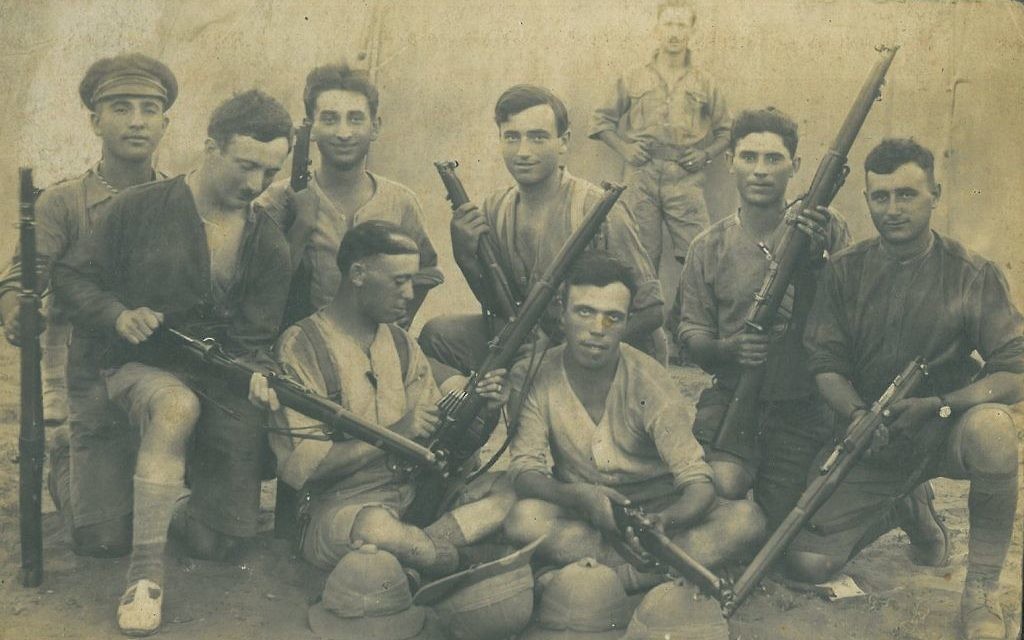Our Patriarch Fought to Free Eretz Yisrael
His descendants who have made aliyah serve in the IDF.

Abe Simon was born in Russia and moved to the United States in 1911. He was a young, sprightly teen who lived in Brooklyn, where his brother had moved into the St. Johns Hotel. His other brother moved to Columbia, S.C.
The Simon brothers were orphans; their two sisters remained in Russia.
Abe was a committed Zionist, participating in activities at the Jewish Educational Alliance on the East Side of New York. His love for Eretz Yisrael was so deep that he knew, even in his teens, that somehow he would reach the Holy Land.
Get The AJT Newsletter by email and never miss our top stories Free Sign Up
Abe wanted to join the U.S. Army in 1917 and go to Europe to fight under Gen. John J. Pershing. But at his draft board in Brooklyn, where several hundred Jewish boys entered the Army, Abe was turned down for being too young.
Disappointed, Abe read circulars in Yiddish of the need for volunteers to join a Jewish army. He signed up at the office on 42nd Street in Manhattan to become a member of the Britain’s Jewish Legion, under the command of Gen. John Henry Patterson of Britain and his deputy, Zeev Jabotinsky.
By now Abe had grown to almost 6 feet. From some surviving photos, we can see his muscles rippling. Part of the first group to arrive in Windsor, Ontario, for training, he joined more than 1,800 Jewish men from Canada and the United States who had enlisted.

A month later, enlistees David Ben-Gurion and Yitzhak Ben Zvi arrived. “Turkish exiles,” they had been living in New York for three years.
They underwent intensive training for two months: learning to fire a weapon with accuracy, learning to crawl with a weapon in hand, experiencing a simulation of the Sinai sands and being schooled to follow the commands of British officers.
They then took a ship to Plymouth, England, for additional preparation before shipping out to Alexandria, Egypt, where they caught a train to the battlefront in the Jordan Valley.
The soldiers came from all parts of the United States and Canada. Jabotinsky left us a national accounting of the 5,000 participants in the Jewish Legion, officially known as the 38th, 39th, 40th, 41st and 42nd Battalions of the Royal Fusiliers: 34 percent from the United States, 30 percent from Palestine, 28 percent from England, 6 percent from Canada and 1 percent from Argentina.
These units arrived in the Jordan Valley in early 1918 and led the fighting at Megiddo and against other Ottoman strongholds.
Unfortunately, the British gave permission for the units to be formed only after the Balfour Declaration was issued in November 1917, so they arrived two months after Gen. Edmund Allenby took Jerusalem. Allenby’s force included English Jews, who helped the Jews of Jerusalem after the city fell.
An American Jewish soldier who arrived in the fall of 1917 to fight with the British was Harry Rosenblatt, who died at age 101 and had an obituary in The New York Times. He was special because he marched under Allenby’s command into Jerusalem on Dec. 11, 1917.
“What was meaningful to the Jews,” he recalled, “was the sight of Allenby walking into the city. He wanted to pay the city its proper due.”
Abe Simon served with all his heart and soul in the battles at Megiddo and other locales in the northern part of the country. He wrote his brother Hyman and stressed “how wonderful it was to have Judean soil in Jews’ hands even though the British were the overseers.”
The most important Zionist act Abe performed was the purchase of karka (land) in what became Herzliya Pituach. Unfortunately, he died in 1949 in his early 50s, so he never could fulfill his dream of aliyah with his family.
After he returned to America in 1920, he lived in Brooklyn and was active in Yiddisher summer camps. Moving to Atlanta in 1927 to be with cousins, he received their aid to open a ladies ready-to-wear shop in Spartanburg, S.C., called Saul’s, named after his Atlanta family.
In 1928 on a visit to family, Abe met Lottie Geffen, 28, the oldest child of Rabbi and Mrs. Tobias Geffen, the senior Orthodox rabbi of Atlanta. They courted between Spartanburg and Atlanta through Yiddish love letters, which have been preserved.
Abe and Lottie married in 1930. They had two children, Harold and Phyllis (of blessed memory), and were active in their synagogue.
During World War II, the United States built an Army training camp outside Spartanburg called Camp Croft, where many Jewish enlistees and draftees underwent basic training. Lottie and Abe Simon led local efforts to provide food and hospitality at the camp and in the city.
When Abe died, his Jewish Legion service was not included in his obituary, nor was it etched into his stone in Southwest Atlanta’s Greenwood Cemetery, where he is buried.
We descendants of Abe’s have been motivated by his fighting and pioneering spirit to make aliyah during the past half-century. Of the 145 descendants of Lottie and Abe’s brothers and sisters who have made aliyah, many have served as tank commanders, others in intelligence units, and the newest is in the Israeli navy. Several have been in Nahal units; others have educated people so they can enter the Israeli army.
Several nephews have served as doctors and attorneys, and one was called up for the Persian Gulf War.
Having just observed the centennial of Allenby’s liberation of Jerusalem on Dec. 11, we salute all members of the Jewish Legion and especially our ancestor Abe Simon z”l.




comments